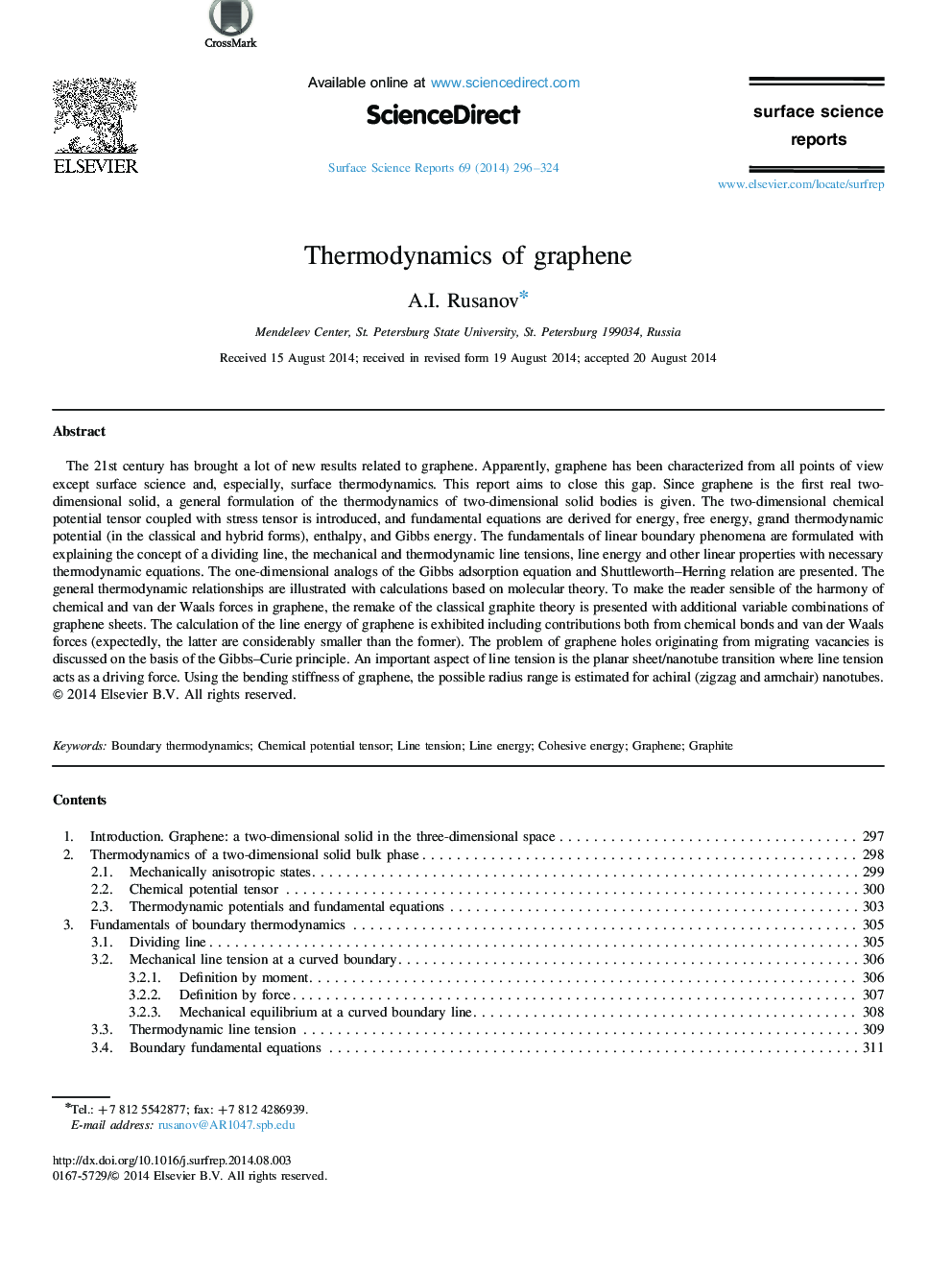| کد مقاله | کد نشریه | سال انتشار | مقاله انگلیسی | نسخه تمام متن |
|---|---|---|---|---|
| 7845126 | 1508426 | 2014 | 29 صفحه PDF | دانلود رایگان |
عنوان انگلیسی مقاله ISI
Thermodynamics of graphene
ترجمه فارسی عنوان
ترمودینامیکی گرافن
دانلود مقاله + سفارش ترجمه
دانلود مقاله ISI انگلیسی
رایگان برای ایرانیان
کلمات کلیدی
ترمودینامیک مرزی، تانسور پتانسیل شیمیایی، تنش خط، انرژی خط، انرژی انعطاف پذیر، گرافن، گرافیت،
ترجمه چکیده
قرن بیست و یکم نتایج بسیار زیادی در رابطه با گرافن به ارمغان آورده است. ظاهرا گرافن از همه ی دیدگاه ها به جز علم سطح و به ویژه ترمودینامیک سطح مشخص شده است. این گزارش با هدف بسته شدن این شکاف است. از آنجایی که گرافن اولین جامد جامد دو بعدی است، یک فرمول کلی از ترمودینامیک ذرات جامد دو بعدی داده شده است. تانسور پتانسیل شیمیایی دو بعدی همراه با تانسور استرس ارائه شده است و معادلات اساسی برای انرژی، انرژی آزاد، پتانسیل ترمودینامیکی بزرگ (در فرم های کلاسیک و هیبرید)، آنتالپی و انرژی گیبس به دست می آیند. اصول پدیده های مرزی خطی با توضیح مفهوم خط تقسیم، تنش مکانیکی و ترمودینامیکی خطی، انرژی خطی و دیگر ویژگی های خطی با معادلات ترمودینامیکی لازم فرموله شده است. آنالوگهای یک بعدی معادله جذب گیبس و رابطه شتلووورث-هرینگس ارائه شده است. روابط کلی ترمودینامیکی با محاسبات بر اساس نظریه مولکولی نشان داده شده است. برای ایجاد خواننده از هماهنگی نیروهای شیمیایی و وناروالز در گرافن، بازنگری از نظریه گرافیت کلاسیک با ترکیب متغیرهای اضافی از ورق های گرافن ارائه شده است. محاسبه انرژی گرافن گرافن از جمله هزینه های شیمیایی و نیروهای ون د واثس نشان داده شده است (انتظار می رود که آنها به طور قابل توجهی کوچکتر از سابق هستند). مشکل حفره های گرافن ناشی از مهاجرت های خالی بر اساس اصل گیبس-کوری مورد بحث قرار گرفته است. یک جنبه مهم تنش خطی انتقال ورق ورق / نانولوله ای است که تنش خطی به عنوان یک نیروی محرکه عمل می کند. با استفاده از سختی خم گرافن، محدوده شعاعی احتمالی برای نانولوله های آیرال (زیگزاگ و صندلی) تخمین زده می شود.
موضوعات مرتبط
مهندسی و علوم پایه
شیمی
شیمی تئوریک و عملی
چکیده انگلیسی
The 21st century has brought a lot of new results related to graphene. Apparently, graphene has been characterized from all points of view except surface science and, especially, surface thermodynamics. This report aims to close this gap. Since graphene is the first real two-dimensional solid, a general formulation of the thermodynamics of two-dimensional solid bodies is given. The two-dimensional chemical potential tensor coupled with stress tensor is introduced, and fundamental equations are derived for energy, free energy, grand thermodynamic potential (in the classical and hybrid forms), enthalpy, and Gibbs energy. The fundamentals of linear boundary phenomena are formulated with explaining the concept of a dividing line, the mechanical and thermodynamic line tensions, line energy and other linear properties with necessary thermodynamic equations. The one-dimensional analogs of the Gibbs adsorption equation and Shuttleworth-Herring relation are presented. The general thermodynamic relationships are illustrated with calculations based on molecular theory. To make the reader sensible of the harmony of chemical and van der Waals forces in graphene, the remake of the classical graphite theory is presented with additional variable combinations of graphene sheets. The calculation of the line energy of graphene is exhibited including contributions both from chemical bonds and van der Waals forces (expectedly, the latter are considerably smaller than the former). The problem of graphene holes originating from migrating vacancies is discussed on the basis of the Gibbs-Curie principle. An important aspect of line tension is the planar sheet/nanotube transition where line tension acts as a driving force. Using the bending stiffness of graphene, the possible radius range is estimated for achiral (zigzag and armchair) nanotubes.
ناشر
Database: Elsevier - ScienceDirect (ساینس دایرکت)
Journal: Surface Science Reports - Volume 69, Issue 4, December 2014, Pages 296-324
Journal: Surface Science Reports - Volume 69, Issue 4, December 2014, Pages 296-324
نویسندگان
A.I. Rusanov,
